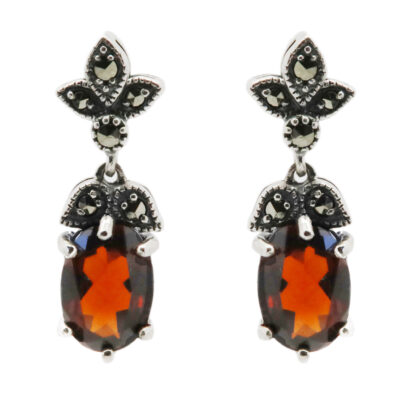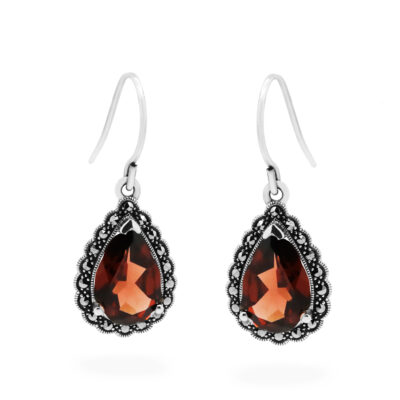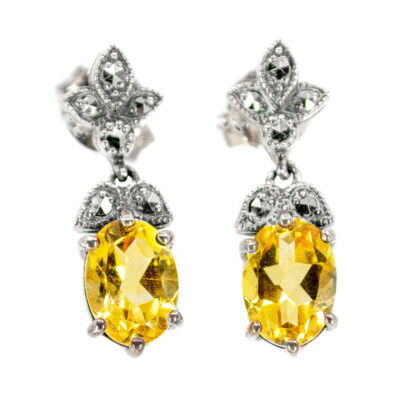These sophisticated Victorian-design pendant earrings features pear-shaped opals decorated with marcasites (pyrite), beautifully crafted in 925′ Silver.
These sophisticated Victorian-design pendant earrings features pear-shaped opals decorated with marcasites (pyrite), beautifully crafted in 925′ Silver.
Details: Opals, Marcasites (pyrite), 925′ Silver Earrings
Weight in grams: 8.
Condition: New.
| Design Era | |
|---|---|
| Design & Historical Context | The Victorian Era spanned Queen Victoria's rule of England from 1837 until 1901. During this time, a middle class began to emerge, sparking a demand for jewelry in the mass market, jewelry trends often reflected the tone of current events. The era is usually divided into several subsections: the Romantic Period from 1837 to 1861, the Grand Period from 1861 to 1880, and the Aesthetic Period from 1880 to 1901. During the Romantic Period jewelry also featured nature-inspired designs, similar to jewelry of the Georgian era. Frequently, these designs were delicately and intricately etched into gold. Lockets and brooches were popular in daytime jewelry during the early Victorian era, whereas colored gemstones and diamonds were worn during the evening. During the Grand Period jewelry , because the Grand or Mid-Victorian era corresponded with the death of Queen Victoria's husband, many jewelry pieces have solemn, somber designs. Known as mourning jewelry, the pieces feature heavy, dark stones. Jet, onyx, amethyst, and garnet are frequently found in jewelry from this period. Compared to previous periods, Mid-Victorian-era jewelry features highly creative, colorful designs using shells, mosaics and gemstones. During the Aesthetic period, jewelers used diamonds and feminine, bright gemstones such as sapphire, peridot, and spinel. Star and crescent designs as well as elaborate hat pins were also popular. Some scholars believe the aesthetic era began sooner, in 1875, and ended as early as 1890. |
| Key Materials | |
| Materials & Craftsmanship | Opal: The Gem of Fire and Illusion Opal is a gemstone unlike any other, renowned for its mesmerizing play of color that seems to shift and dance with every movement. This captivating stone comes in a variety of colors, from milky whites and soft pinks to deep blacks and fiery reds, all displaying a unique iridescence known as "opalescence." Opal has a rich history and has been prized by many cultures for its mystical qualities. The ancient Romans believed opals brought good luck, while in medieval Europe, they were considered a symbol of hope, purity, and truth. The word "opal" itself is derived from the Greek word "opallios," meaning "to see a change in color," a fitting name for this ever-changing gem. In the world of jewelry, opal is valued for its unique beauty and variety. Though relatively soft, with a Mohs hardness of 5.5 to 6.5, opals are often set in protective settings to preserve their delicate structure. They are used in rings, earrings, pendants, and brooches, where their shifting colors add a dynamic and ethereal quality to each piece. Opal is more than just a gemstone; it is a symbol of creativity, spontaneity, and emotional expression. Its stunning play of color and rich historical background make it a cherished and enchanting choice for jewelry that captures the imagination. Marcasite (pyrite): The Gem of Timeless Elegance and Vintage Charm Marcasite, often mistakenly referred to as pyrite, is a gemstone that has captivated jewelry enthusiasts for centuries with its metallic luster and vintage appeal. Although marcasite is technically a form of pyrite, true marcasite jewelry is made from pyrite crystals that are cut and polished to create a shimmering, antique look. Historically, marcasite has been admired for its mysterious, reflective surface, often used in intricate, filigree designs during the Victorian and Art Deco periods. In the 18th and 19th centuries, it became particularly popular in Europe as a more affordable alternative to diamonds, lending an air of elegance and sophistication to brooches, rings, and other accessories. In modern jewelry, marcasite is prized for its ability to add a touch of vintage charm and drama to any piece. Its metallic, gunmetal-gray hue pairs beautifully with silver settings, and its natural sparkle makes it a standout in both understated and ornate designs. Marcasite is commonly seen in rings, earrings, pendants, and brooches, often set in sterling silver to enhance its classic, antique look. Marcasite is more than just a gemstone; it is a symbol of timeless elegance and enduring style. Its historical significance and unique, reflective quality make it a cherished choice for jewelry that exudes both character and sophistication, perfect for those who appreciate the charm of vintage-inspired designs. 925' Silver: The Metal of Elegance and Versatility Silver, known for its bright, reflective luster, is one of the most beloved and widely used precious metals in the world. This versatile metal has been cherished for thousands of years, not only for its beauty but also for its malleability, making it ideal for crafting intricate and delicate jewelry designs. Historically, silver has been associated with the moon and considered a symbol of purity, clarity, and protection. Ancient civilizations, from the Egyptians to the Greeks and Romans, valued silver for its beauty and used it to create coins, jewelry, and religious artifacts. In many cultures, silver is also believed to have healing properties, often used in amulets and talismans to ward off negative energy. In modern jewelry, silver is prized for its affordability, versatility, and timeless appeal. Sterling silver, an alloy of 92.5% pure silver and 7.5% other metals (usually copper), is the standard used in high-quality jewelry. Its durability and bright, reflective surface make it an excellent choice for a wide range of designs, from minimalist pieces to ornate creations. Silver can be polished to a high shine or given a matte, oxidized, or antiqued finish to suit various styles. Silver is more than just a metal; it is a symbol of elegance, flexibility, and understated luxury. Its enduring popularity and wide-ranging applications make it a staple in jewelry that can complement any look, from casual to formal, with timeless grace. |
| Gender | |
| Weight (in grams) | 8 |
| Condition |
By following these tips, you can enjoy your precious jewelry for many years to come.
Related Products
-
Marcasite (Pyrite) Onyx Silver Pendant Earrings 14780-1858
€ 135,00 VAT incl. (where applicable) -
Marcasite (Pyrite) Onyx Silver Pendant Earrings 14770-1848
€ 195,00 VAT incl. (where applicable) -
Garnet Marcasite (Pyrite) Silver Pendant Earrings 17145-2866
€ 125,00 VAT incl. (where applicable) -
Garnet Marcasite (Pyrite) Silver Pendant Earrings 13942-1417
€ 145,00 VAT incl. (where applicable) -
Marcasite (Pyrite) Onyx Silver Pendant Earrings 16467-2608
€ 135,00 VAT incl. (where applicable) -
Citrine Marcasite (Pyrite) Silver Pendant Earrings 17144-2865
€ 125,00 VAT incl. (where applicable) -
Marcasite (Pyrite) Pearl Turquoise Silver Pendant Earrings 15410-2160
€ 155,00 VAT incl. (where applicable) -
Amethyst Marcasite (Pyrite) Silver Pendant Earrings 14427-1614
€ 165,00 VAT incl. (where applicable)
- Home
- Collection
- Fine Jewelry
- Silver Jewelry
- Silverware
- Boxes
- Candlesticks
- Salt and pepper shakers
- Miniatures
- Salt cellars
- Spoon Set
- Condiments
- Frames
- Napkin Ring
- Spoon
- Oddities
- Cups
- Vases
- Cutlery
- Serving Spoon And Cake Server
- Candlesticks
- Baskets
- Hanukkiah
- Spice Tower
- Yad
- Tea Set
- Sugar Castor
- Napkin Rings
- Wine Bottle Coaster
- Wine Stopper
- Tea Pot
- Jugs
- Rattles
- Hip Flask
- Miscellaneous
- Rings 💍
- About
- Contact











